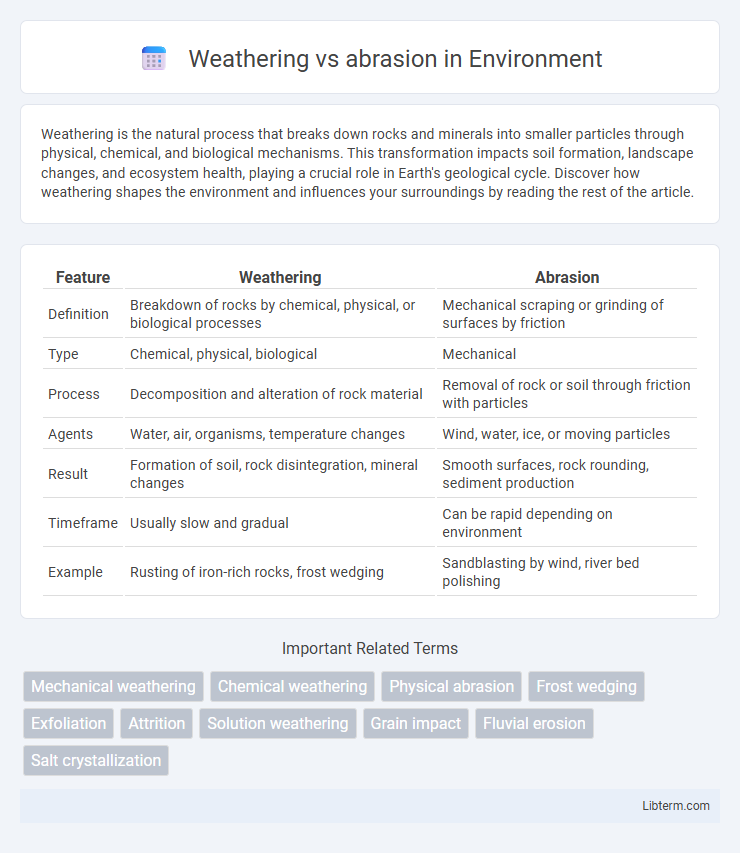Weathering is the natural process that breaks down rocks and minerals into smaller particles through physical, chemical, and biological mechanisms. This transformation impacts soil formation, landscape changes, and ecosystem health, playing a crucial role in Earth's geological cycle. Discover how weathering shapes the environment and influences your surroundings by reading the rest of the article.
Table of Comparison
| Feature | Weathering | Abrasion |
|---|---|---|
| Definition | Breakdown of rocks by chemical, physical, or biological processes | Mechanical scraping or grinding of surfaces by friction |
| Type | Chemical, physical, biological | Mechanical |
| Process | Decomposition and alteration of rock material | Removal of rock or soil through friction with particles |
| Agents | Water, air, organisms, temperature changes | Wind, water, ice, or moving particles |
| Result | Formation of soil, rock disintegration, mineral changes | Smooth surfaces, rock rounding, sediment production |
| Timeframe | Usually slow and gradual | Can be rapid depending on environment |
| Example | Rusting of iron-rich rocks, frost wedging | Sandblasting by wind, river bed polishing |
Introduction to Weathering and Abrasion
Weathering is the natural process of breaking down rocks and minerals through chemical, physical, or biological mechanisms, altering the Earth's surface over time. Abrasion specifically refers to the mechanical scraping or wearing away of rock surfaces by friction from particles like sand, water, or ice. Both processes play crucial roles in shaping landscapes, but weathering involves decomposition while abrasion involves physical erosion.
Defining Weathering: Processes and Types
Weathering is the natural process that breaks down rocks and minerals on Earth's surface through mechanical, chemical, and biological means. Mechanical weathering includes physical forces like freeze-thaw cycles, thermal expansion, and exfoliation, while chemical weathering involves reactions such as hydrolysis, oxidation, and carbonation that alter rock composition. Biological weathering results from plant roots, microorganisms, and animal activity contributing to rock disintegration and mineral transformation.
Understanding Abrasion: Mechanisms and Effects
Abrasion is a mechanical weathering process where rock surfaces are worn down by friction and impact from particles like sand, gravel, and other rock fragments transported by wind, water, or ice. This process alters the texture and shape of rocks, contributing to soil formation and landscape changes. Abrasion intensity depends on factors such as particle size, hardness, velocity, and the duration of contact with the rock surface.
Key Differences Between Weathering and Abrasion
Weathering primarily involves the chemical and physical breakdown of rocks and minerals at or near the Earth's surface, leading to decomposition and alteration without movement. Abrasion refers to the mechanical scraping or wearing down of rock surfaces caused by friction from particles or other rock fragments during transport. Key differences include weathering's focus on in-place rock disintegration and chemical changes, whereas abrasion entails physical erosion through direct contact and friction during material movement.
Chemical vs. Physical Changes in Weathering
Weathering involves chemical changes that alter the mineral composition of rocks, breaking them down through reactions with water, acids, and gases. Abrasion is a physical process where mechanical forces, such as wind, water, or ice, grind and scrape rock surfaces without changing their chemical structure. Chemical weathering forms new minerals like clay or oxides, while abrasion primarily reduces rock size and smooths surfaces through physical friction.
Agents Responsible for Abrasion
Abrasion is primarily caused by agents like wind, water, ice, and gravity carrying sediments and particles that scrape and wear down rock surfaces. Glaciers contribute to abrasion through embedded rocks grinding against bedrock during movement, while rivers transport sand and gravel that erode banks and beds. Wind-driven particles also act as an abrasive force in arid environments, smoothing and shaping exposed rock formations.
Real-World Examples of Weathering
Weathering breaks down rocks through natural processes like freezing and thawing, as seen in the formation of potholes on roads during winter. Chemical weathering occurs when acid rain dissolves limestone structures, such as the erosion of statues in urban areas. Biological weathering is evident when plant roots grow into cracks in rocks, gradually splitting them apart in mountainous regions.
Natural Environments Impacted by Abrasion
Abrasion significantly reshapes natural environments such as riverbeds, coastal cliffs, and desert landscapes by wearing away rock surfaces through the friction of particles like sand, pebbles, and larger sediments transported by wind, water, or ice. This mechanical erosion process contributes to soil formation and the smoothing of rock faces, influencing habitat structure and biodiversity in these ecosystems. Unlike weathering, which chemically or physically breaks down rock in place, abrasion actively relocates and grinds materials, accelerating landscape evolution in dynamic environments.
The Role of Climate in Weathering and Abrasion
Climate significantly influences weathering processes, with warm, humid climates accelerating chemical weathering through enhanced hydrolysis and oxidation reactions. In contrast, abrasion primarily depends on mechanical forces such as wind, water, or glacier movement, which are intensified in arid or cold climates where freeze-thaw cycles increase rock fragmentation. The interplay between climate-driven moisture levels and temperature variations determines the predominance and rate of weathering versus abrasion in different environments.
Importance of Weathering and Abrasion in Landscape Formation
Weathering breaks down rocks through chemical, physical, or biological processes, creating soil and altering landscapes by producing sediments that shape landforms over time. Abrasion, a mechanical process where particles scrape and wear down rock surfaces, contributes to sculpting valleys, cliffs, and riverbeds by smoothing and eroding exposed materials. Together, weathering and abrasion drive landscape evolution by continuously modifying earth materials, influencing soil fertility, sediment transport, and ecosystem development.
Weathering Infographic

 libterm.com
libterm.com